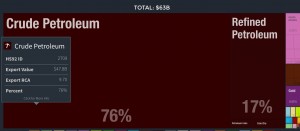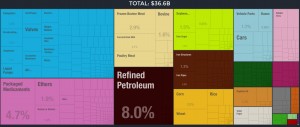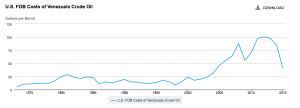Venezuela began to face detrimentally high inflation in 2014, right after the death of previous President Hugo Chavez. Although this was not the beginning of the country’s monetary problems, high inflation has led to a huge decrease in the value of the Bolivar, Venezuela’s currency. Now prices of regular goods and services have skyrocketed. Not only has inflation led to the devaluation of the bolivar but it has also caused Venezuela’s government to panic and take precaution in order to make some goods and services cheap while others are staying severely expensive.
In attempt to resolve and or manage the high inflation, the government created a system that has four different exchange rates. This includes the black market within the four. To explain this complex system simply, we can divide the four exchange rates into categories in which prices are set to particular goods and services. Basically, the government sells dollars at an exchange rate of 6.3 and 12 bolivars per dollar. These first two rates buy necessity imports such as food and medicine. Although that may not seem like a high exchange rate, it severely impacts the country in other ways, which will be discussed later. The third rate is 172 bolivars per dollar. This rate is for people who are unauthorized to exchange their bolivars to dollars at the other preferred rates. In terms of the black market rates, goods and services could start anywhere from 170 to 3,500 bolivars according to Venezuela Live Economic Data.
The Problem
Due to various exchange rates and high inflation, the bolivar has decreased in value. For those who are unaware, Venezuela’s main export is petroleum. To emphasize the importance of this main export on the Venezuelan economy, petroleum makes up 93% of all their exports. This means the country depends on oil to generate almost 100% of the country’s total export revenue. With a devaluation of their currency, Venezuela is exporting a highly prized good for dirt cheap. The graph below displays the amount in dollars the US has paid for one barrel of oil over a given period of time. In 2012, the US paid the highest of $100 per barrel of oil. After the highest point on the graph which is in 2010, the price of oil rapidly decreases. More recently in 2015, which is the very end of the graph, the US only paid $40.75 per barrel. Now with a decrease in value of the bolivar and decrease price of oil, Venezuela is not nearly generating the amount of dollars the country needs to buy important resources.
Dollars per Barrel of Oil https://www.eia.gov/dnav/pet/hist/LeafHandler.ashx?n=PET&s=IVE0000004&f=A
Since Venezuela is not making nearly as much oil revenue as in the past, the government is experiencing a shortage of dollars. This has created a domino-like effect on the Venezuelan economy. If Venezuela is only exporting oil and other industrious materials, we can assume that most other goods and services need to be imported. Since the bolivar is useless to other countries, Venezuela uses the dollars earned from oil to buy those important goods and services. However, since Venezuela is generating a lot less oil revenue due to the devolution of the bolivar, there is a shortage of dollars in the country. To give more of perspective on the problems generated by the dollar shortage, below there are two images from the Observatory of Economic Complexity. This site has generated a visualization of international trade data.
 Venezuela’s Export Distribution http://atlas.media.mit.edu/en/profile/country/ven/
Venezuela’s Export Distribution http://atlas.media.mit.edu/en/profile/country/ven/
The image above displays the countries total export revenue at $63 Billion in 2014. Unfortunately, it seems the website has not been able to update since then. However, it is shown that Venezuela’s economy is only based on oil revenues, even the small portions of the countries exports are in related markets. Although this revenue number may not be currently up to date, we know that since 2014 oil prices in Venezuela have plummeted, which have caused the revenue from oil to also decrease. As we notice, Venezuela doesn’t generate food products w or medicine which means the country needs to import these important goods and services. Next, we can look at the imports.
 Venezuela’s Import Distribution http://atlas.media.mit.edu/en/profile/country/ven/
Venezuela’s Import Distribution http://atlas.media.mit.edu/en/profile/country/ven/
The image above is a report of Venezuela’s imports. The image may be hard to see but the biggest squares represent different kinds of food and medicine products. With the shortage, the Venezuelan government doesn’t have enough dollars to provide basic foods and medicine. Venezuela’s dollar shortage has created a shortage of all other goods and serviced people need to survive. This shortage has led Venezuela into an economic crisis. People are not able to access the food they need to survive. Others are dying of curable diseases because medicine has become extremely scarce. Venezuela seemingly will continue to face this economic crisis until a solution can be created.

